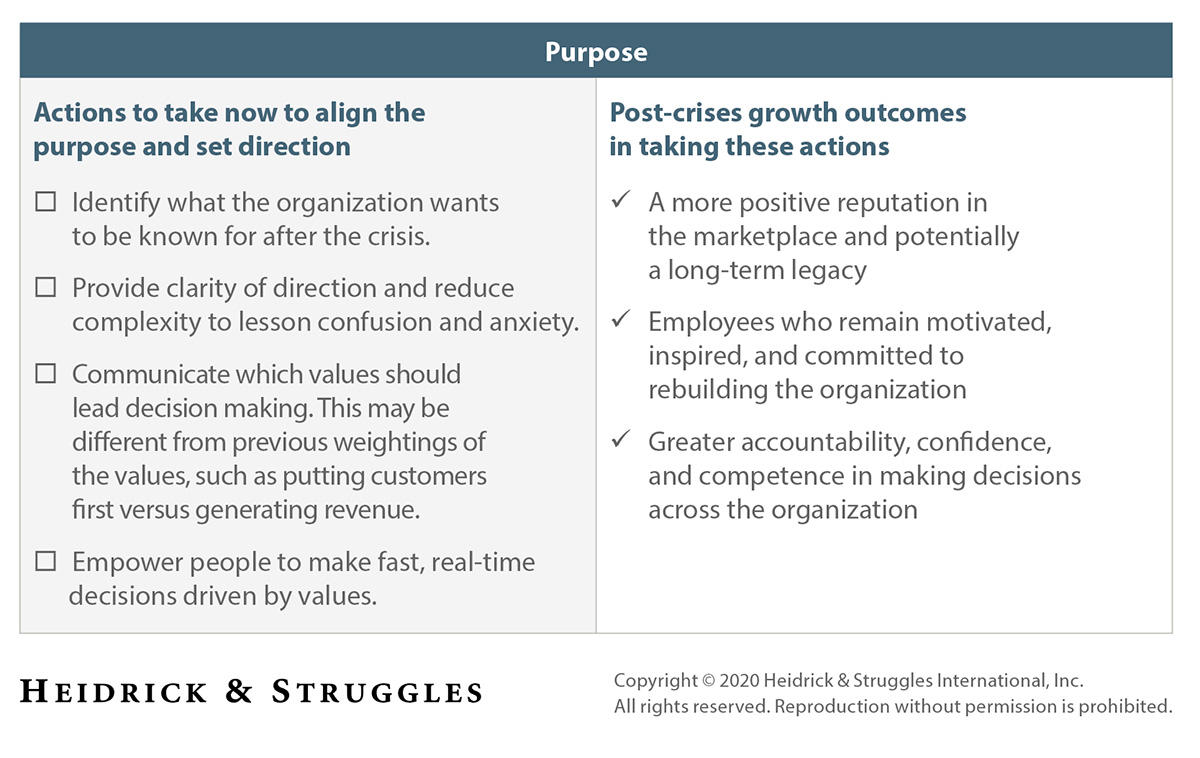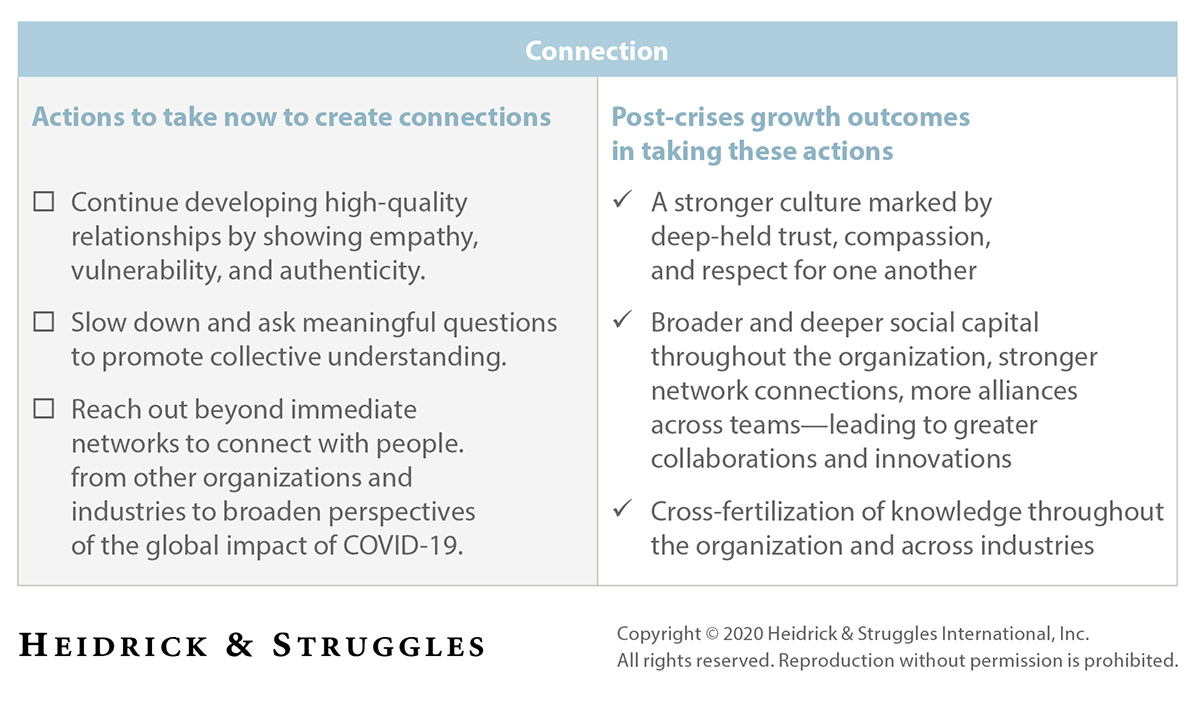Talent Strategy Management
How leaders can help workers thrive now—and build a foundation for growth
As the world learns to adjust to new ways of interacting and working during the COVID-19 crisis, many people are striving to strike a delicate balance between looking optimistically to the future and considering how best to thrive now. For leaders, tough questions of what business will look like post-crisis mingle with urgent concerns of what is best for their people in the present. The good news is that the answers can be more closely aligned than many leaders might expect.
The human ingenuity and resilience that people have shown in prior crises both highlight how people can adapt and inform how businesses can evolve. The positive strategies that people engage in to manage a crisis—such as reaching out for support, persevering, and experimenting with alternative solutions—are also how people build resilience, and typically lead to longer-term growth for their organizations.
Leaders can learn from past experiences and encourage a range of healthy behaviors to help their employees flourish in a time of uncertainty, as well as leverage these behaviors and practices in the long term to become even stronger. To support their employees and ensure they thrive during and after the crisis, leaders can invest in and encourage three key areas now: purpose, vitality, and connection. These areas support the well-being of all members of the organization, encourage decision-making led by longer-term goals and values, and help leaders build the foundation for a company that can operate better—and return to growth—in the future.
Purpose: Aligning decisions and goals to the organization’s greater mission and values |
In the initial days of the crisis—when millions of employees were asked to work from home and self-isolate, and jobs that had never before been dangerous in any way were suddenly potentially life-threatening—there was a great deal of shock and uncertainty. People didn’t know which functions of their business would shut down and how their customers would be affected. In such volatile times, leading with a greater purpose and values can provide clear direction, give meaning and inspiration to everyday actions, and compel better long-term decision-making and growth.
Leaders need to be clear about how their decisions align with company values, as well as how they’re supporting the global community. In some cases, the organization’s values need to be reprioritized, from results to customers and employees. Ted Ogawa, the CEO of Toyota Motor North America, for example, pledged manufacturing and engineering resources to produce face shields and ventilators and articulated the company’s commitment to supporting the medical community via Toyota’s core value to “contribute to society in meaningful ways beyond providing mobility for customers.”1 Efforts that are more internally focused can also help to connect values with employees, offering them a level of comfort. After their companies had been financially hammered, multiple CEOs and executive committees in the hospitality and retail industries forfeited their salaries for the duration of the crisis.2 Some organizations also moved quickly to help financially support frontline workers, increasing hourly wages, bonuses, paid leave, and additional benefits. While actions like these will not offset all the financial pain many employees are feeling, it can mitigate it. Leaders who appeal to employees’ ideals about doing right for the larger public and role-model those same ideals through their decisions create greater trust and inspire community-based on common values.
Having a clear purpose can help guide quick decision-making, which is particularly helpful when decisions that will affect the long term have to be made sooner rather than later. As novel challenges rapidly arise across the organization, leaders do not have the luxury of wading through the typical decision-making hierarchies. Using purpose and values as a compass can help leaders and the whole organization implement a strategic shift with more confidence because they will know it aligns with the organization’s overarching direction.
After a crisis, trust and common values can inspire the organization to be rebuilt stronger, more resilient, and further committed to its purpose. That, in turn, will allow the organization to harness collective action and lead to more confident and competent decision-making across the organization for the long term. The legacy of having applied those values to support the global community during a crisis will go a long way in building greater trust among customers and employees as well as a positive legacy in society.

Vitality: Fostering an environment of optimism, well-being, and perseverance |
During a crisis, a focus on vitality—which can include physical health and well-being as well as spirit and determination—is crucial. COVID-19 is both a physical and mental threat. People are challenged with completely overhauling how they manage their daily lives, interact with friends and family, and maintain their professional responsibilities in new working conditions. These stressors, while significant, pale in comparison to the stress of protecting against, being ill with, or recovering from the virus. Leaders insisting on employees working while sick or injured tends to lead to longer recovery times and poorer productivity; more importantly, that sends the wrong message throughout an organization’s culture.3 To safeguard vitality during the crisis, leaders need to ensure—and model—balanced and flexible work schedules, extend benefits and make existing ones accessible, and foster a culture of trust, resilience, and optimism. On the personal level, some leaders have implemented strict lunch hours and others have emphasized flexible work schedules for people managing childcare and homeschooling.
As governments slowly start to reopen business and some normal work operations resume, it’s important that leaders continue to be flexible in safeguarding the health of their employees and making them feel comfortable. Transparent communication is key to helping employees understand that their choices are being respected and that they’re not being forced into unsafe situations.
Ensuring employees understand their benefits and how to access them is another critical element of safeguarding health. Many organizations have extended mental-health benefits and rapidly organized pandemic-specific health benefits. At some organizations, this includes providing healthcare coverage for workers they have laid off, which is reassuring both for the laid-off workers (many of whom leaders hope to rehire) and for employees who are still working. Throughout all of this, human resources leaders have been at the forefront of managing employees’ health and finding ways to create greater bandwidth within the organization.
Vitality can also be strengthened by cultivating employees’ sense of hope and optimism, which are closely linked and related to higher employee performance, job satisfaction, and organizational commitment.4 Employees who feel positive about their company’s future are more likely to put in the hard work to push past obstacles and create that future. Leaders can raise their employees’ spirits, and therefore perseverance, by expressing their own hopefulness. Additionally, sharing stories of past obstacles that the organization has overcome and transparent communications about the present and the future all help to boost employee energy. Applying these flexible and empathetic practices for vitality after a crisis can contribute to a healthier workforce in the long term—creating a greater trust that leadership has employees’ best interests in mind and more confidence in the organization’s ability to persevere in the future.

Connection: Creating supportive networks and collaboration through high-quality relationships, empathy, and authenticity |
We’ve learned that robust connection among people in times of crisis is critical to recovery. Some people reach out for emotional support, others seek out tangible advice for working through adversity, and yet others look for ways to make sense of the larger situation. These acts are rarely isolated, but each has its own unique benefit. They can provide some emotional release and new coping mechanisms, create stronger bonds, and offer different perspectives for understanding the crisis. Leaders can and should create an environment where strong networks and relationships are prioritized. Connections help ensure the fabric of the organization remains strong, create more positive cultures, and can contribute to greater psychological safety. Informal discussions—sharing struggles or positive moments outside of work with colleagues—and more formal conversations such as leadership roundtables offer beneficial forms of connection.
Additionally, the urgency and necessity to resolve problems have pushed previously siloed or competitive groups together to collaborate effectively. As organizations move past the crisis, it is important to maintain these new unifications, as they help increase simplicity within the organization. To do this, organizations and leaders need to be intentional about fostering these collaborations, rather than letting old rivalries and bureaucracies get in the way.
Beyond the workplace, people are seeking to make sense of this disruption in their lives and understand the new reality in which they live, work, and interact. This reorienting is being done among people in organizations, on calls and videoconferences, behind plastic walls in pharmacies and makeshift masks throughout hospitals, and everywhere essential workers congregate. These conversations will continue to occur as people reintegrate into workplaces and start to understand which of these changes will last. Leaders can help workers on this journey by showing authenticity, compassion, and vulnerability about their own uncertainty. Maintaining these robust connections after a crisis can build a stronger organizational culture and deeper networks—ones that are based on greater compassion, respect, collaboration, and sharing of knowledge.
Through greater collaboration and information sharing, companies can accelerate innovation that can help with future challenges.

Although a great deal of unknown territory lies ahead, focusing their actions in these three areas now will help leaders support their people (and themselves) and enable them to thrive. Investing in these principles can help not only shepherd a company through turbulent times but also cultivate a more agile, resilient culture that will lead to a growth mindset across the organization in the long run.
A crisis often upends assumptions about a business, industries, or even the economy, creating an opportunity for innovation and growth. Organizations that can carry through the agility and lessons learned during times of uncertainty will be better positioned to resolve challenges and mitigate risk in the future. By having foresight, organizations can slow down to speed up. They can plan for the future by identifying how to best use the disruption to their advantage. By leading through both a crisis and this subsequent period of growth, leaders can develop broader skill sets, more empathy, and greater resilience for future challenges. This is what the world will need as it heals and rebuilds.
About the author
Emily Amdurer (eamdurer@heidrick.com) is a principal in Heidrick & Struggles’ New York office and a member of Heidrick Consulting.
References
1 Toyota, “We are here for you! Toyota’s response to the COVID-19 crisis,” March 27, 2020.
2 Jack Kelly, “CEOs are cutting their own salaries in response to the coronavirus,” Forbes, March 30, 2020.
3 Charmi Patel, Pawan Budhwar, and Arup Varma, “Overall justice, work group identification, and work outcomes: Test of moderated mediation process,” Journal of World Business, Volume 47, Number 2, April 2011, pp. 213–22.
4 Carolyn M. Youssef and Fred Luthans, “Positive organizational behavior in the workplace: The impact of hope, optimism, and resilience,” Journal of Management, Volume 33, Number 5, 2007, pp. 774–800.